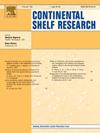Biochemical implications of the Bottom Boundary Layer Detachment at the Mid-Atlantic Bight shelf-break front
IF 2.2
3区 地球科学
Q2 OCEANOGRAPHY
引用次数: 0
Abstract
The Mid-Atlantic Bight frontal system along the U.S. northeast shelf is rich in biodiversity. In this region, primary production is influenced by a variety of upwelling processes, including internal instabilities of the front, off-shore forcing from Gulf Stream rings, and wind-driven flows. It is noteworthy that the concentrations of chlorophyll-a (Chl-a) in the shelf-break region are not consistently enhanced throughout the year, although local increases of phytoplankton biomass have been observed in some circumstances. In this work, we investigate the frontal dynamics of one of the possible mechanisms affecting primary production: upwelling via detachment of the Bottom Boundary Layer (BBL). The annual variability of the surface Chl-a in the shelf-break region reveals a 5- to 20-day period, which is potentially consistent with nutrient upwelling associated with the BBL detachment. Details of the process are examined using in situ data by quantifying along-isopycnal changes in properties. As frontal isopycnals rise in the water column, nitrate tends to decrease and Chl-a tends to increase, suggesting utilization of upwelled nutrients by phytoplankton. However, significant fluctuations can be attributed to sample size, intrinsic data variability, and the assumption of homogeneity in the along-shelf dimension.
中大西洋浅海架断裂锋底边界层剥离的生化意义
沿美国东北大陆架的中大西洋白锋系统生物多样性丰富。在该地区,初级生产受到各种上升流过程的影响,包括锋面的内部不稳定、墨西哥湾流环的离岸强迫以及风驱动流。值得注意的是,尽管在某些情况下观察到浮游植物生物量的局部增加,但大陆架断裂区叶绿素-a (Chl-a)的浓度并不是全年都在增加。在这项工作中,我们研究了影响初级生产的可能机制之一的锋面动力学:通过底部边界层(BBL)分离的上升流。大陆架断裂区地表Chl-a的年变化周期为5 ~ 20天,这可能与与BBL分离相关的营养物上升流相一致。该过程的细节是通过量化沿等径变化的性质,使用原位数据进行检查。随着水柱锋面等斜线的升高,硝酸盐呈下降趋势,而Chl-a呈上升趋势,说明浮游植物利用了上涌的营养物。然而,显著的波动可归因于样本量、内在数据变异性以及沿货架维度的同质性假设。
本文章由计算机程序翻译,如有差异,请以英文原文为准。
求助全文
约1分钟内获得全文
求助全文
来源期刊

Continental Shelf Research
地学-海洋学
CiteScore
4.30
自引率
4.30%
发文量
136
审稿时长
6.1 months
期刊介绍:
Continental Shelf Research publishes articles dealing with the biological, chemical, geological and physical oceanography of the shallow marine environment, from coastal and estuarine waters out to the shelf break. The continental shelf is a critical environment within the land-ocean continuum, and many processes, functions and problems in the continental shelf are driven by terrestrial inputs transported through the rivers and estuaries to the coastal and continental shelf areas. Manuscripts that deal with these topics must make a clear link to the continental shelf. Examples of research areas include:
Physical sedimentology and geomorphology
Geochemistry of the coastal ocean (inorganic and organic)
Marine environment and anthropogenic effects
Interaction of physical dynamics with natural and manmade shoreline features
Benthic, phytoplankton and zooplankton ecology
Coastal water and sediment quality, and ecosystem health
Benthic-pelagic coupling (physical and biogeochemical)
Interactions between physical dynamics (waves, currents, mixing, etc.) and biogeochemical cycles
Estuarine, coastal and shelf sea modelling and process studies.
 求助内容:
求助内容: 应助结果提醒方式:
应助结果提醒方式:


